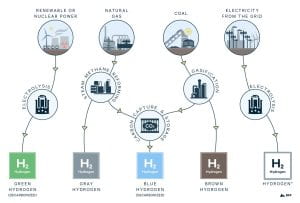The United States spends over $820 billion every year on the health impacts related to fossil fuel pollution. This means that ⅕ of every dollar put towards health care in America is spent on the consequences of fossil fuels. Yet, a new study reveals the U.S. as one of the potential leaders in green hydrogen production. Green hydrogen, a carbon neutral fuel source, may be the world’s best bet to replace fossil fuels in the near term.
While hydrogen fuel can be produced in different ways, green hydrogen has the most potential. Green hydrogen is produced via electrolysis, the electrical separation of water into oxygen and hydrogen. When the energy for electrolysis comes from a renewable source of electricity, no carbon dioxide is produced. That makes green hydrogen a promising strategy in the face of global warming.
The problem is that 95% of hydrogen today is produced from natural gas or coal powered processes — these are categorized as gray hydrogen or brown hydrogen. So how do policymakers, businesses, and energy industry leaders know if pursuing a green hydrogen transition is worth it?

| Different forms of hydrogen production processes (source: Resources for the Future). |
The researchers from four universities across Russia addressed this very question. By examining factors including national goals, production costs, access to materials, current reliance on other energy sources, and potential for renewable energy sources, they found a high chance for a successful shift towards green hydrogen in the United States.
This potential means a lot. In general, hydrogen is a useful resource. Currently, most of the hydrogen consumed in the United States is used for refining petroleum, treating metals, producing fertilizers, and processing foods. As a fuel source, hydrogen proves very promising because burning hydrogen produces no CO2 or other pollutants. This is unlike other energy sources, such as natural gas which makes up 40% of all energy in the US, yet produces greenhouse gas emissions including CO2, methane, and nitrous oxide.
Green hydrogen is particularly useful for the expansion of renewable energy. When it is abundant, renewable electricity can be used to produce green hydrogen. The green hydrogen can then be stored or transported until it is needed. This means green hydrogen can help smooth over energy slumps, such as during low-sunshine or low-wind, as well as spread the benefits of renewable energy past the immediate solar or wind farm. Unlike the technology that currently exists for this purpose, such as batteries, technology that utilizes hydrogen like fuel cells are more efficient and still produce no emissions.
Green hydrogen is not a perfect solution in the fight against climate change. Transporting hydrogen is difficult. Hydrogen has a lower energy density than other fuel sources, so more hydrogen is required to deliver the same amount of energy.
Additionally, hydrogen must be pressurized or compressed into a gas or liquid. Liquefying hydrogen requires cooling it down to −253°C (−423°F) and uses nearly 30% of the energy content of the hydrogen itself, while transporting gasified hydrogen necessitates pressurized cylinders or pipelines. Transporting hydrogen is both energy intensive and expensive.
It can also be explosive. Hydrogen is odorless and tasteless, meaning there is the risk of undetected leaks. Hydrogen is explosive and flammable, with a less visible flame than other similarly flammable materials. Much of the current research in hydrogen fuel centers around transporting it, such as improving compression processes or development of alloys for hydrogen storage, but there is still much work to be done.
Green hydrogen is more than just a fuel with a fancy name. It has the power to drastically cut CO2 emissions globally while also elevating the communities that currently suffer the effects of the energy industry. These five researchers have done the important work of demonstrating how great the potential is. Now, it is up to voters, advocates, engineers, and policymakers to make green hydrogen the new green reality.